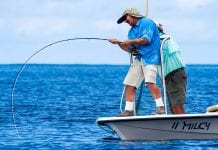LEGERING Part Two – Quivertipping on a Stillwater
In part 1 of this legering series I covered the background to legering and introduced the quiver tip as a method of bite indication.
Now in part 2 I will show you how to set up a simple, light quivertip rig for use on a stillwater for catching smaller fish like roach, perch and skimmer bream.
The Tackle For quivertipping on a stillwater for small to average sized fish your set-up should be geared towards sensitivity.
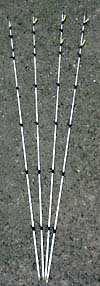 Therefore the rod should have a soft action and be around 11ft in length with the quivertip fitted, certainly not any shorter. A soft-action rod will prevent small hooks pulling out of fish on the strike. Too stiff a rod has no initial ‘give’ as you strike and small hooks can easily come adrift from their hold in the fish’s mouth.
Therefore the rod should have a soft action and be around 11ft in length with the quivertip fitted, certainly not any shorter. A soft-action rod will prevent small hooks pulling out of fish on the strike. Too stiff a rod has no initial ‘give’ as you strike and small hooks can easily come adrift from their hold in the fish’s mouth.
The rod should be fitted with a fine fibre glass quivertip of not more than a 1oz rating, preferably around ¾oz if possible. A stillwater will not have any flow to put additional pressure on the quivertip, so the only tension will come from tightening up the line to the terminal tackle. This enables the use of a very sensitive tip on which you will spot the smallest of movements from shy-biting fish.
The reel should be a fixed spool, either 2000 or 3000 size, loaded with approximately 3lb breaking strain sinking line. It is important to have sinking line otherwise tightening up the line between the quiver and terminal rig can take an age, especially in windy weather. The reel should also have a line clip incorporated into the spool to aid accurate casting, which I explain how to do below.
When you get proficient with this quivertipping technique you might want to consider using braided lines, especially when targeting bream or fishing at distance. Because it has no stretch the shyest of bites are magnified on the quivertip. However, striking into and playing fish has to be tempered down to prevent hook pulls when using braid.
The Business End
The terminal tackle on this set-up involves tying a very simple paternoster rig which can be used with either an Arlesey bomb type leger weight or a small feeder.
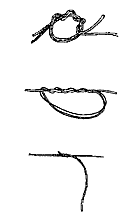
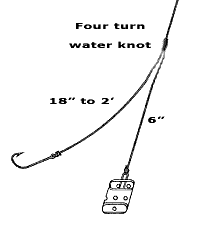
Four turn water knot Fixed Paternoster
Tie an overhand loop in the end of the mainline on which to connect your hook link ‘loop to loop’ style. Then, using a four turn water knot, attach an additional short length of line, of either of the same breaking strain or less, to the mainline around four inches above the loop. This additional link of line should be between four and six inches long when tied and should have a quick release snap link swivel attached to it. Onto this snap link will go either the bomb or feeder.
The hook should be matched to the bait, so assuming maggots are the hookbait, use an 18 or 20 tied to a 2lb to 2½lb hooklength. The hooklength may need to be varied in length to optimise bites, but around 18 inches to 2ft is a good length to start with.
This rig is very sensitive as there is a direct line between the hook and the quivertip. When a fish picks up the bait and moves off it does not feel the weight of the leger or feeder attached to the link. The only resistance comes from the quivertip itself, hence the reason for using the softest one available. Stiffer quivertips just introduce more resistance to a taking fish, giving them more of an opportunity to reject the hookbait.
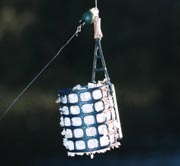 |
| Open end feeder – “cage feeder” shown here |
Leads or Feeders?
Because of the snap link swivel this rig is very versatile and can be used with straight leads, maggot feeders or groundbait feeders. By using the snap link swivel you can change between feeders and bombs with ease if you wish, with no need to retie the rig.
The choice of which to use is governed by the target species, type of venue and conditions on the day. You may decide, especially if bream are the target, to introduce an initial amount of groundbait into the swim by hand, in which case you would start with an Arlesey bomb on the link and maybe change to an open-end groundbait feeder later in the session to top up the initial feed.
Alternatively you may feel building up a swim gradually is the way to go, but still using groundbait. In this instance you would opt for an open-end groundbait feeder from the start. In colder weather especially it may be prudent to just introduce a few maggots each cast in which case you should opt for a small blockend maggot feeder. Whatever you choose, this simple paternoster rig allows you to change between the three with ease.
 The Right Way Round
The Right Way Round
There is most definitely a right and a wrong way to position yourself and your quivertip rod when you fish on a stillwater. It is essential that you fish with your rod tip at as close to 90 degrees (right angles) to the bait as you can so you get the maximum deflection in the quiver tip when a fish picks up your bait. Therefore, assuming you are fishing straight out from the bank, the rod should be positioned parallel to bank.
If you hold your rod in your right hand the rod should be positioned to your right so that when you strike at a bite you are striking away from your body, not across it. Striking a bite on a quiver requires sweeping the rod back and slightly up in smooth arc, picking up the line and setting the hook effectively. Striking across you body reduces the available distance you have to move your rod.
Position the rod so that the quivertip is as close to the water’s surface as you can get it. This reduces the effect of any breeze bouncing the fine tip, making bites hard to spot. You can use just a front rest if you wish with the butt on your knee, or use two rests, whichever is more comfortable. If using two rests make sure you are seated with your striking hand in close proximity to the rod butt as you will need to pick the rod up quickly to connect with most bites.
Accurate Casting
As with any type of fishing accurate casting is essential. In fact if you are using a feeder it is even more essential as you need to keep the bait going into the same small area every time. Unlike float fishing you don’t have the luxury of over casting and drawing your rig back.
So how do you ensure that your feeder lands in the same place every cast? It’s done like this: The direction you cast can be determined by picking a fixed landmark, like a bush or tree, on the opposite bank and making sure you cast at this fixed point every time. Pick the spot that you want to fish towards and make your first cast. If you are happy with the distance, clip the line into the line clip on the spool of your reel.
The line clip is used to govern the maximum distance you can cast. When you next retrieve your feeder the line clip will stop you casting beyond your previous cast. Providing you fish towards your landmark every time and with enough power, the line will stop at the line clip and land in the same place every single time, giving you a tight bed of feed with your hookbait in it.
Make sure your cast is smooth and controlled each time. As you release your line on the cast, bring your rod back up to the vertical and, as the cast hits the line clip, drop the rod tip to absorb the shock and land the feeder gently onto the water. With practise you will develop the power, timing and accuracy required that lands your feeder perfectly every time.
Once your feeder is in position you should set the rod in the rod rests and take up the slack line between the rod tip and the feeder. The line should be tightened until the quiver tip just starts to bend towards the hookbait, ensuring the tip is as close to the water as you can get it.
Spotting the Bite
Bites on the quivertip can be anything from a tiny pull to a savage bend in the rod. Whatever you do, especially if there are carp or decent tench in the water, do not stray from your rod. With the line tight to the bait there is every possibility that a decent fish will pull your rod in if you are not ready for it.
 |
| Block-end feeder |
I have a basic rule for striking at quivertip bites – if it pulls round, irrespective of how far, and stays there without springing back – strike! Even big fish will sometimes move the tip only a fraction, but providing it doesn’t drop back again it is likely that the fish has the bait in its mouth and a firm strike often connects. However when the tip ‘rattles’, that is, it pulls round sharply and drops quickly back again, sit on your hands. Some fish, especially small roach, peck at the bait and spit it out again quickly. Wait until the tip pulls round and stays round, or indeed keeps going, before setting the hook.
Another bite you may encounter is the drop-back. This where a fish picks up the bait and moves directly at you. It won’t move the quivertip until the leger or feeder is dislodged, causing the tension to go out of the line. The tip will then spring straight and the line will go slack. Strike when this happens.
Hints and Tips
Quivertips are pretty strong given their thin construction. However they can break and one of the most common ways of breaking a quiver is by accidentally getting the line wrapped around the tip ring. This usually occurs when loading the feeder with bait and having a slack line between the feeder and the rod tip allowing the line to wrap around the top of the rod. If you don’t notice this, disaster will strike with the tip snapping or splitting when you cast. To prevent this always keep a tension between the feeder and the rod tip when loading the feeder with bait or baiting your hook.
To help spot shy bites, especially in winter, use a target board. You can buy these or make them yourself. A target board sits in front of your quiver tip and provides you with an even still surface against which you can view the quivertip much easier. Continuously looking at a tip against a moving or uneven background, like the water’s surface or grass blowing in a breeze, can strain your eyes and make spotting bites quite hard. Using a target board helps relieve the strain and makes spotting even the smallest movement a doddle.
If bites are shy, or not being spotted at all, resulting in sucked maggots or stolen bait, play around with the length of the hooklink until you find the optimum length.
Cast the feeder constantly, with a maximum of five minutes between casts, even if you are not getting bites. Fish will come to feed eventually. In colder months when using a maggot feeder, just put half a dozen maggots in the feeder at a time but keep it going in constantly.
That’s it for part 2. In part 3 of this legering series I will show you how to set up and fish with bobbins and bite alarms as your bite indicators, targeting larger fish like tench, bream or carp on a stillwater. See you then.
| FIRST CLASS FISHING | |
‘First Class Fishing’, a series of classes for beginners and improvers conducted by Dave Cooper, an all-round experienced angler with a string of good fish and good catches to his credit. The classes are aimed at those who have recently discovered the joys of fishing and need guidance on using tackle correctly and wish to improve their basic skills. Dave will cover a specific topic at a time in this bi-weekly column. The first section will be really basic with subsequent ones building on the skills covered previously. His aim is to explain things as simply and concisely as possible and will assume that the reader knows absolutely nothing about the subject. |












